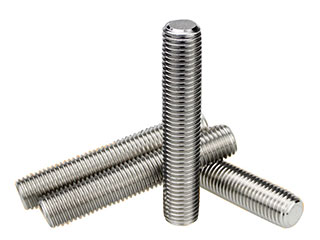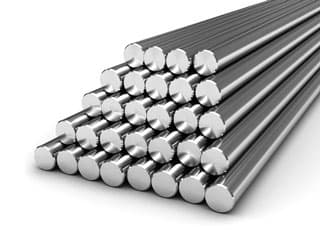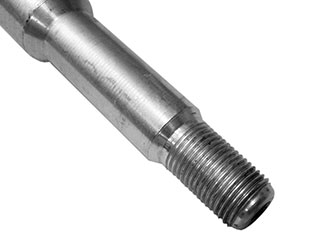EQUIPMENT FOR STUD BOLT AND PIN PRODUCTION
THREADED ROD
A threaded rod, also known as a stud, is a relatively long rod that is threaded on both ends; the thread may extend along the complete length of the rod. They are designed to be used in tension.Threaded rod in bar stock form is often called all-thread. Studs may have a drive slot in one end to facilitate installing the stud.
With respect to shape, stud bolts a.k.a. studs are categorized into 3 basic types: "Fully Threaded Stud Bolts", "Tap End Stud Bolts", and "Double End Stud Bolts". Each of these studs have different application. As name suggests, fully threaded studs have full body coverage with threads for full engagement of the matings nuts or similar parts. Tap end studs have threads at extreme ends of the body with unequal thread engagement length, while double end stud bolts have equal thread length at both ends.
Apart from these there are stud bolts for flanges which are fully threaded studs with chamfered ends, and double end studs with reduced shank for special bolting applications.
For studs that are not completely threaded, there are two types of studs: full-bodied studs, and undercut studs.
Full-bodied studs have a shank equal to the major diameter of the thread.
Undercut studs have a shank equal to the pitch diameter of the screw thread. Undercut studs are designed to better distribute axial stresses. In a full-bodied stud the stresses are greater in the threads than in the shank. Undercut studs (rolled thread) are also stronger because the metal is "rolled" up to the major diameter, not removed. This preserves the grain of the steel, and in some cases even enhances it.
Full bodied studs (cut thread) are weaker because metal is removed to create the thread, disturbing the grain of the steel. Undercut studs are only required in applications where the stud is exposed to fatigue. Cut threads are entirely suitable for many applications, even when rolled threads might be slightly stronger. Mass-produced fasteners (standard bolts and studs) are usually rolled, but jobbed parts with custom features and small lot sizes are likely to be cut (from Wikipedia, the free encyclopedia).
COLD FORMING EQUIPMENT FOR STUD BOLTS AND PIN PRODUCTION




TMA offers RYH and RZH series cold heading machines for the production of studs from 30 to 400 mm in length at a capacity of 26-200 pcs/min.
THREAD ROLLING MACHINES FOR PINS
 Thread rolling automatic machines are designed for the production of threaded rods, standard DIN 525, DIN 835, DIN 938, DIN 939, DIN 975, DIN 976-1, DIN 976, etc.; thread rolling on bars of hydraulic type with cross-flow and feed to the passage in standard configuration.
Thread rolling automatic machines are designed for the production of threaded rods, standard DIN 525, DIN 835, DIN 938, DIN 939, DIN 975, DIN 976-1, DIN 976, etc.; thread rolling on bars of hydraulic type with cross-flow and feed to the passage in standard configuration.
The hydraulic supply pressure is adjustable from 0.5 tons to meet all production needs. On some models, the cross-flow cycle time is controlled by a timer and a feed delay switch. This makes it easy to roll thin and coarse shapes with easy adjustment.
Semi-automatic and fully-automatic loading system options, pedal control system and electrical backstops are available on request.
The equipment is especially well suited for the production of long screw threads and precision threads, spline, worm and gear for machine and equipment components, tools, motorcycles, construction machinery, car parts, etc.
CHAMFERING MACHINES FOR STUDS

 The chamfering machines are a line of metalworking equipment which is widely used in many production processes for the removal of coarse layering, welding residue, primary corrosion, burrs, etc. on pipe ends, studs, rods and in the face of further processing operations. Chamfering machines are designed for finishing the workpiece.
The chamfering machines are a line of metalworking equipment which is widely used in many production processes for the removal of coarse layering, welding residue, primary corrosion, burrs, etc. on pipe ends, studs, rods and in the face of further processing operations. Chamfering machines are designed for finishing the workpiece.
RGS-33/42-B7 chamfering and stamping machine line is designed for production of B7 high-strength studs. Each model of chamfering machine is designed for a wide range of wire diameters and lengths. These CE-approved machines are safe, easy to set up and require little maintenance. They are designed specifically for the production of small and medium batches of studs.
The double-sided chamfering machines RGM-XX-D series grind straight bars after the drawing machine and chamfer both sides of the bar diameter range from Ø5 mm to Ø76 mm at lengths of 1 to 8 meters. These beveling machines can be operated as stand-alone machines or as part of a bar processing line. The special design of the machining heads allows several operations and grinding of the finished workpiece with facing, chamfering and central hole.
STRAIGHT-CUTTING MACHINES FOR STUD BOLTS
 Straight-cutting machines of RG-AY series are designed for automatic unwinding of wire from the coiled wire, straightening, wire feeding to the required length and cutting to size. The equipment produces measuring bars and studs, standard DIN 525, DIN 835, DIN 938, DIN 939, DIN 975, DIN 976-1, DIN 976 and others.
Straight-cutting machines of RG-AY series are designed for automatic unwinding of wire from the coiled wire, straightening, wire feeding to the required length and cutting to size. The equipment produces measuring bars and studs, standard DIN 525, DIN 835, DIN 938, DIN 939, DIN 975, DIN 976-1, DIN 976 and others.
The minimum length of the workpiece to be cut is 30 mm, the maximum length is within 12 meters. Straightening is carried out by a rotating straightening frame (rotor type) by multiple transverse plastic bending of the wire with special crackers installed in the slots of the straightening frame.
Wire feed is carried out by drive rollers located before and after the correct frame. The length of the cut is controlled by an electric mechanism; the equipment has high performance and is convenient in maintenance and operation.
New patented hydraulic cutting and feeding, adjustable machine speed. Optionally, it can be equipped with a chamfering machine.
MULTIOPERATION MACHINES FOR STUD BOLT PRODUCTION
 The servo operated line of turning machines RGV-XX series perform multiple operations at the same time, and replace traditional automatic lathes in production of straight parts with turned ends. The machines are equipped with 2-4 turning stations on each side, that turn, chamfer, and drill bar ends to virtually any requested length and diameter.
The servo operated line of turning machines RGV-XX series perform multiple operations at the same time, and replace traditional automatic lathes in production of straight parts with turned ends. The machines are equipped with 2-4 turning stations on each side, that turn, chamfer, and drill bar ends to virtually any requested length and diameter.
The RGA-T series of multi-purpose machines combines traditional thread rolling and bending with secondary operations. The machines can perform many secondary operations, including chamfering, cross drilling, workpiece face drilling, alignment, stamping, marking, chiselling and even connecting rods, washers, etc., thread rolling by using of a planetary system, bending (optional). The multifunctional equipment of the RGA-T series is used to manufacture a number of fasteners such as B7 studs, welded studs, long blanks for long bolts with a head, bicycle axles with rounded ends, bolts with a pointed end, blanks for threaded rods made of high-strength and stainless steel.